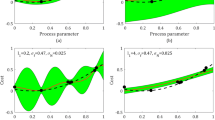Abstract
A novel optimisation technique based on quantum computing principles, namely the quantum based optimisation method (QBOM), is proposed to solve the surface grinding process problem optimisation. In grinding process there is a trade-off between faster material removal rates, with a reduction in cutting time and its associated cost and shorter tool life or higher tool cost. The objective of the surface grinding optimisation problem is to determine the optimal machining conditions, which will minimize the unit production cost and unit production time with the finest possible surface finish but without violating any imposed constraints. The performance of QBOM is investigated against two test cases, one of a rough grinding process and the other of a finished grinding process and the computational results show that the proposed optimisation technique obtained better results than most of the methods presented in the literatures.








Similar content being viewed by others
Notes
Hadamard transformation takes a basis state and transforms it into a linear combination of two basis states.
References
Alfares, F. S. (2004). Novel optimisation algorithms based on quantum computing principles. West of London: Brunel University.
Alfares, F. S., & Esat, I. I. (2006). Real-coded quantum inspired evolution algorithm applied to engineering optimization problems. In Proceedings of the second international symposium on leveraging applications of formal methods, verification and validation (pp. 169–176).
Baskar, N., Saravanan, R., Asokan, P., & Prabhaharan, P. (2004). Ant colony algorithm approach for multi-objective optimisation of surface grinding operations. The International Journal of Advanced Manufacturing Technology, 23(5), 311–317.
Dusan, P., & Miroslav, R. (2013). Using genetic algorithm for optimization of turning machining process. Journal of Engineering Studies and Research, 19(1), 47–53.
Grover, L. K. (1996). A fast quantum mechanical algorithm for database search. In Proceedings of the twenty-eighth annual ACM symposium on theory of computing, Philadelphia, PA, United States (pp. 212–219).
Han, K. H., & Kim, J. H. (2002). Quantum-inspired evolutionary algorithm for a class of combinatorial optimization. IEEE Transactions on Evolutionary Computation, 6(6), 580–593.
Karpuschewski, B., & Inasaki, I. (2006). Monitoring systems for grinding processes. In L. Wang & R. X. Gao (Eds.), Condition monitoring and control for intelligent manufacturing. Springer series in advanced manufacturing (pp. 83–107). Berlin: Springer.
Kodali, S. P., Kudikala, R., & Deb, K. (2008). Multi-objective optimization of surface grinding process using NSGA II. In First international conference on emerging trends in engineering and technology, Nagpur, Maharashtra, India (pp. 763–767).
Kolahan, F., & Liang, M. (2000). Optimization of hole-making operations: A tabu-search approach. International Journal of Machine Tools and Manufacture, 40, 1735–1753.
Krishna, A. G. (2007). Selection of optimal conditions in the surface grinding process using a differential evolution approach. Proceedings of the Institution of Mechanical Engineers, Part B: Journal of Engineering Manufacture, 221(7), 1185–1192.
Krishna, A. G., & Rao, K. M. (2006). Multi-objective optimisation of surface grinding operations using scatter search approach. The International Journal of Advanced Manufacturing Technology, 29(5), 475–480.
Kurt, M., Bagci, E., & Kaynak, Y. (2009). Application of Taguchi methods in the optimization of cutting parameters for surface finish and hole diameter accuracy in dry drilling processes. The International Journal of Advanced Manufacturing Technology, 40(5), 458–469.
Lee, K. M., Hsu, M. R., Chou, J. H., & Guo, C. Y. (2011). Improved differential evolution approach for optimization of surface grinding process. Expert Systems with Applications, 38(5), 5680–5686.
Lin, X., & Li, H. (2008). Enhanced Pareto particle swarm approach for multi-objective optimization of surface grinding process. In Proceedings of the 2008 second international symposium on intelligent information technology application (Vol. 2, pp. 618–623).
Liu, X., Yi, H., & Ni, Z. (2013). Application of ant colony optimization algorithm in process planning optimization. Journal of Intelligent Manufacturing, 24(1), 1–13.
Maulik, B. N., & Patel, D. A. (2014). Parametric optimization of face milling using harmony search algorithm. International Journal of Engineering Development and Research, 2(2), 2321–9939.
Milfelner, M., Župerl, U., & Čuš, F. (2004). Optimisation of cutting parameters in high speed milling process by GA. International Journal of Simulation Modelling, 3, 121–131.
Nandi, A. K., Pratihar, D. K., & Banerjee, M. K. (2004). Prediction of grinding power and surface finish—A GA-fuzzy approach. Integrated Computer-Aided Engineering, 11(4), 373–382.
Prabu, P. M., Rajasekar, K. P., Vignesh, R. D., & Navaneethasanthakumar, S. (2014). Scatter search optimization for multi node machining fixture layout. The International Journal of Engineering and Science, 3(1), 30–37.
Rao, R. V., & Pawar, P. J. (2010). Grinding process parameter optimization using non-traditional optimization algorithms. Proceedings of the Institution of Mechanical Engineers, Part B: Journal of Engineering Manufacture, 224(6), 847–852.
Rao, R. V., Rai, D. P., & Balic, J. (2016). Multi-objective optimization of machining and micro-machining processes using non-dominated sorting teaching-learning-based optimization algorithm. Journal of Intelligent Manufacturing. doi:10.1007/s10845-016-1210-5.
Saravanan, R., Asokan, P., & Sachidanandam, S. (2002). A multi-objective genetic algorithm (GA) approach for optimization of surface grinding operations. International Journal of Machine Tools and Manufacture, 42(12), 1327–1334.
Wen, M. X., Tay, A. A. O., & Nee, A. Y. C. (1992). Micro-computer-based optimization of the surface grinding process. Journal of Materials Processing Technology, 29(1–3), 75–90.
Yildiz, A. R. (2009). A novel particle swarm optimization approach for product design and manufacturing. International Journal of Advanced Manufacturing Technology, 40, 617–628.
Yildiz, A. R. (2013). Hybrid Taguchi-differential evolution algorithm for optimization of multi-pass turning operations. Applied Soft Computing, 13, 1433–1439.
Yildiz, A. R., & Solanki, K. N. (2012). Multi- objective optimization of vehicle crashworthiness using a new particle swarm based approach. The International Journal of Advanced Manufacturing Technology, 59(1), 367–376.
Zhang, G. (2011). Quantum-inspired evolutionary algorithms: A survey and empirical study. Journal of Heuristics, 17(3), 303–351.
Author information
Authors and Affiliations
Corresponding author
Rights and permissions
About this article
Cite this article
Alajmi, M.S., Alfares, F.S. & Alfares, M.S. Selection of optimal conditions in the surface grinding process using the quantum based optimisation method. J Intell Manuf 30, 1469–1481 (2019). https://doi.org/10.1007/s10845-017-1326-2
Received:
Accepted:
Published:
Issue Date:
DOI: https://doi.org/10.1007/s10845-017-1326-2




